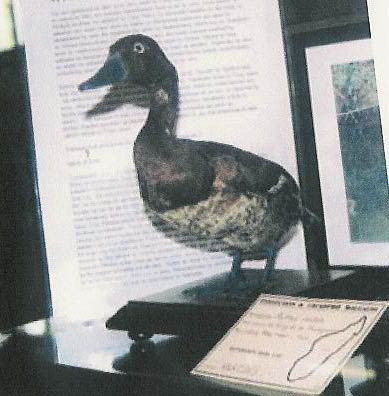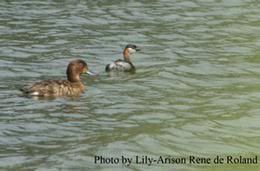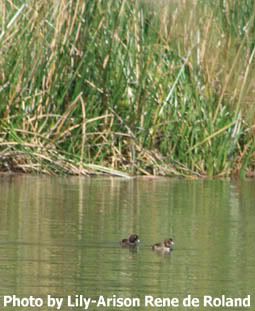|
|
Post by dysmorodrepanis on Jun 23, 2005 14:31:36 GMT
really nice plates  I had only seen about one of these before. Do you know from which book they are? Delacour's "Waterfowl of the World": mawba.com/identify.htmThe uppermost photo should be one of the last knwon bird, which was kept in captivity in Antananarivo Zoo until it dies. The photo of the dead bird could be the same individual after its was prepared as a specimen (it looks quite fresh). There is another nice photo of the same bird in HBW (vol1, p569). |
|
|
|
Post by another specialist on Jul 22, 2005 7:16:08 GMT
here is the direct link of the newer addition The Waterfowl of the World (Volumes 1 through 4) by Jean Delacour (Author), Peter Scott (Illustrator) Hardcover Publisher: Arco Publishing Co. (1973) Language: English ISBN: 0668029706 tinyurl.com/7sk2bnot available but you can order second hand copy as and when there available..... dysmorodrepanis information was already provided about book and link to site was provided also |
|
|
|
Post by Melanie on Aug 19, 2005 15:24:11 GMT
Photo of dead specimen  |
|
|
|
Post by another specialist on Oct 23, 2005 20:56:42 GMT
Aythya innotata Madagascar Pochard Madagaskarwitoogeend (Dutch) ZMA 15246 Click image for a larger version Critically Endangered or (more likely) Extinct Once a breeder of wetlands on the northern plateau of central Madagascar, with a major stronghold in the basin of Lake Alaotra. Favoured lakes and ponds rich in aquatic vegetation and with plenty cover on the shore. Many of the smaller wetlands on the plateau have been drained now, and the larger Lake Alaotra suffers heavily from pollution, cutting and grazing of the fringing vegetation, and overfishing (see the grebes, Tachybaptes). No former estimates of the numbers of this duck have been made, but in any case it was only locally common and the total range was small; the present situation seems bleak, with none seen since 1991. Items in the ZMA - 1 bird: ZMA 15246 Adult male, 9 Jun 1960, near Ambatosoratra (17°34'S, 48°32'E), southern Lake Alaotra, Madagascar, coll. H.A.W. Smit 165, skin ['weight 680 gr.']. Remarks The bird in the ZMA, shot from a flock of c. 20 birds, belonged to one of the last known survivors of its species: subsequently to this, only one unconfirmed sighting was noted in Antananarivo in 1970, while a live male was captured at Lake Alaotra in 1991 at a moment that the species was already thought to be extinct. None has been seen since then, and it likely has gone forever. ip30.eti.uva.nl/zma3d/detail_search.php for Aythya innotata |
|
|
|
Post by sebbe67 on May 13, 2006 9:13:46 GMT
|
|
|
|
Post by sebbe67 on May 13, 2006 9:14:34 GMT
Aythya innotata
Alternative name:
Madagascan White-eye
Restricted to central Madagascar, the current status of this rare white-eye is uncertain; there have been no sightings in recent years.
FIELD IDENTIFICATION Length 46 cm 18 ml. At rest: A medium-sized dark diving duck, unlikely to be confused owing to its limited range in central Madagascar, where it is the only diving duck apart from distinctive White-backed Duck. Resembles Ferruginous Duck , but rather larger and with more rounded, less peaked, crown shape. Males are darker on head and breast than Ferruginous Duck, offering more contrast with duller brown flanks. Duller and browner females resemble those of Ferruginous Duck in plumage, but ranges do not overlap. No Madagascar Pochards are held in captivity at present. In flight: Resembles Ferrugi
VOICE Calls have been described as similar to those of Redhead. DESCRIPTION Sexes rather similar. Seasonally variable. Adult male breeding: Head and neck dark purplish-chestnut, lacking white chin spot of Ferruginous Duck. Breast dark chestnut, flanks and ventral region reddish-brown; belly and under tail coverts white, with more diffuse border between white of belly and brown of flanks than on Ferruginous Duck. Upper parts blackish, with browner mantle. Wing similar to that of Ferruginous Duck, but white of flight feathers a little less extensive. Adult male eclipse: Distinctly duller and browner, recalling female, but retains white iris. Adult female: Head, neck and breast dull brownish-chestnut, belly less cleanly white; differs from eclipse male in having dark iris. Juvenile: Resembles female, but lighter and duller brown on head and body, with little rufous. Young males attain pale iris during first winter.
BARE PARTS Little information on age or sex variations. Bill lead-grey, with black nail. Legs and feet grey. Iris white on adult males, dark brown on females, pale grey on first-winter males.
MEASUREMENTS Males larger than females. Wing of male 190-201, of female 188-195; tarsus 28-33; bill 44-49; weight no data.
GEOGRAPHICAL VARIATION None. Although superficially similar to Ferruginous Duck, it strangely recalls Redhead of North America in voice, display behavior, head shape and size.
HABITS Little information. Breeding season probably October-January. Feeds chiefly by diving. Flight fast and strong, but not often seen on the wing. Behavior presumed to resemble that of others of genus.
HABITAT Freshwater lakes and marshes.
DISTRIBUTION Known only from lakes and marshes of the plateau of central Madagascar, from Lake Alaotra south to Antsirabe, with centre of population on Lake Alaotra. No recent records.
POPULATION Described as common in 1929 on Lake Alaotra, but visits in 1970s failed to find any. It was also reported on a pond near Antsirabe in 1930 and was seen on Lake Ambohibao in 1970, but there have been no subsequent reports. Introduced large fish in Lake Alaotra are considered to have aided the decline by killing ducklings, but doubtless shooting is an important factor. Like other Madagascar ducks this species is not protected, and commercial duck-shooting is rife. If it still exists, then the only way to save the species is by captive breeding, creation of sanctuaries and the enforcement of protective measures. Although it was kept in captivity for a time before the Second World War, none is held at present.
|
|
|
|
Post by Carlos on May 14, 2006 16:27:53 GMT
The photography of the last known individual (a drake) to date, published in HBW1. Photo taken by Lucienne Wilmé at Antananarivo Botanical Garden, where this individual caught in a gill net in 1991 at Alaotra Lake was kept until it died. |
|
|
|
Post by sebbe67 on May 14, 2006 19:49:13 GMT
 from a museum on Madagascar |
|
|
|
Post by sebbe67 on Nov 21, 2006 19:21:16 GMT
AMAZING NEWS MY FRIENDS!Diving duck resurfaces20-11-2006 The Madagascar Pochard, a diving duck last sighted in 1991 and feared ‘Possibly Extinct’, has been rediscovered during a survey in remote northern Madagascar. Conservationists from The Peregrine Fund Madagascar Project, discovered nine adults and four recently-hatched young on a remote lake, and have since revisited the site for further observations and data. “This is an exciting discovery that strengthens our conviction that putting well-trained biologists into the field to learn about species is critical for conservation success,” said Rick Watson, International Programs Director for The Peregrine Fund. “Spectacular rediscoveries like this are extremely rare, but they provide a glimmer of hope for the 14 other bird species classified as Possibly Extinct.” —Stuart Butchart , Global Species Programme Coordinator, BirdLife International The Madagascar Pochard Aythya innotata was until recently listed as Critically Endangered (Possibly Extinct). The last pochard sighting was on Lake Alaotra in the Central Plateau of Madagascar in 1991 when a male was captured and kept in Antananarivo Zoological and Botanical Gardens until its death one year later. The lack of subsequent records despite intensive searches, and the intensity of threats to the species, had led to it being tagged as Possibly Extinct. The last record of multiple birds dates back to June 1960 when 20 birds were sighted on Lake Alaotra. The decline of the Madagascar Pochard is thought to have started in the mid-20th century and has been linked with degrading lake and marshland habitat from introduced plant and fish species, conversion to rice paddies, and burning. Little is known about the pochard, an extremely secretive and often solitary bird that prefers shallow and marshy habitat. “Spectacular rediscoveries like this are extremely rare, but they provide a glimmer of hope for the 14 other bird species classified as Possibly Extinct.” said Stuart Butchart, Global Species Programme Coordinator, BirdLife International. I simply cant explain what a happyness I felt when I read the following news, its simply to good to be true. www.birdlife.org/news/news/2006/11/madagascar_pochard_redisc.html
|
|
|
|
Post by Melanie on Nov 21, 2006 19:35:49 GMT
Thanks alot. Moved to Rediscovered
|
|
|
|
Post by Melanie on Nov 21, 2006 19:37:16 GMT
 Lily-Arison Rene de Roland, The Peregrine Fund Madagascar Pochard - adult male Does this duck looks happy? |
|
|
|
Post by sebbe67 on Nov 21, 2006 19:45:09 GMT
Hehe at least he should be happy, the chicks is good news and this could well be one of very few remaining populations; just hope that there aint any introduced fishes in this lake and that it will get full protection (if it not have protection already), it would be very intresting to know the name of the lake; maybe the Alotra grebe also lurks in this area.
|
|
Deleted
Deleted Member
Posts: 0
|
Post by Deleted on Nov 21, 2006 19:58:41 GMT
Fine !
Let's hope that it is possible to save these last birds for good !!!
|
|
|
|
Post by dysmorodrepanis on Nov 21, 2006 20:22:16 GMT
www.peregrinefund.org/press_full.asp?id=110&category=Madagascar%20ProjectPhotos & videos!!! Does anybody know what the 1991 bird died of? I hope they breed well in captivity. Population size may be a major problem. Tis might just be the offspring of a single pair (all the rediscovered birds), I think if it's any possible to capture a young couple next spring without harming these birds they shoud try.
|
|
|
|
Post by another specialist on Nov 22, 2006 15:06:54 GMT
great news that it has been rediscovered
|
|
|
|
Post by pigraffles on Nov 24, 2006 10:37:49 GMT
Has anyone seen this, very good news, not only for this bird but perhaps other malagasy freshwater endemics
Home > News > News Search >
Lily-Arison Rene de Roland, The Peregrine Fund
Madagascar Pochard - adult male
Zoom In
Diving duck resurfaces
20-11-2006
The Madagascar Pochard, a diving duck last sighted in 1991 and feared ‘Possibly Extinct’, has been rediscovered during a survey in remote northern Madagascar.
Conservationists from The Peregrine Fund Madagascar Project, discovered nine adults and four recently-hatched young on a remote lake, and have since revisited the site for further observations and data.
“This is an exciting discovery that strengthens our conviction that putting well-trained biologists into the field to learn about species is critical for conservation success,” said Rick Watson, International Programs Director for The Peregrine Fund.
“With better knowledge about the habitat requirements of the Madagascar Pochard comes greater hopes for protecting the species and this area of marshland – a habitat on which many other threatened species may depend.” —Vony Raminoarisoa, Director of BirdLife International Madagascar Programme
The Madagascar Pochard Aythya innotata was until recently listed as Critically Endangered (Possibly Extinct). The last pochard sighting was on Lake Alaotra in the Central Plateau of Madagascar in 1991 when a male was captured and kept in Antananarivo Zoological and Botanical Gardens until its death one year later. The lack of subsequent records despite intensive searches, and the intensity of threats to the species, had led to it being tagged as Possibly Extinct.
The last record of multiple birds dates back to June 1960 when 20 birds were sighted on Lake Alaotra.
“After so much searching, and so long without a sighting, hope seemed to be fading for this species." said Vony Raminoarisoa, Director of BirdLife International Madagascar Programme. "With better knowledge about the habitat requirements of the Madagascar Pochard comes greater hopes for protecting the species and this area of marshland – a habitat on which many other threatened species may depend.”
The decline of the Madagascar Pochard is thought to have started in the mid-20th century and has been linked with degrading lake and marshland habitat from introduced plant and fish species, conversion to rice paddies, and burning. Little is known about the pochard, an extremely secretive and often solitary bird that prefers shallow and marshy habitat.
"The finding encourages us to consider more seriously the possibly that Madagascar's other 'Possibly Extinct' waterbird, the Alaotra Grebe, may not have been restricted to Lake Alaotra (where it no longer occurs); perhaps it occurred elsewhere, and perhaps it still does" said Roger Safford, Programme & Projects Manager, BirdLife International.
|
|
|
|
Post by pigraffles on Nov 24, 2006 10:38:32 GMT
whoops very sorry just saw the next page, will checl more closely next time
|
|
|
|
Post by pigraffles on Nov 24, 2006 10:40:32 GMT
but it is an important point about the grebe and probably also any endemic fish species that may have gone extinct. But give it a couple of years and someone will introduce foreign fish species into the lake
|
|
|
|
Post by sebbe67 on Dec 1, 2006 15:00:05 GMT
Some info about the locality where the bird was rediscovered We observed nine adults and four young of Madagascar Pochard while conducting bird surveys in a remote part of northern Madagascar on November 2006. The site is localised approximatively 330 km from lac Alaotra. The lake where we rediscovered the species seems a volcanic lake surrounded by humid forest, recolonised by aquatic vegetation round the edge and not favourable to rice cultivation. Local people said that the lake contains no fish and water temperature is relatively low, so the lake habitat is undisturbed by human activities. We suggest two hypotheses to explain the context. First, the lack of researches and investigations throughout the country leads many scientists to consider the species as Extinct and restricted to the lac Alaotra region. Secondly, people may have transported some birds during the old migration of Sihanaka between Ambatondrazaka region and the northern part of Madagascar. So in older time, immigrant people carried Madagascar Pochard to domesticate those birds, but they escaped and established in the wild? We recommend listing the species as Critically Endangered. www.birdlifeforums.org/WebX?50@53.QY57aWUfcor.0@.2cba27bb |
|
|
|
Post by another specialist on May 1, 2008 19:29:46 GMT
'Extinct' Madagascar Pochard re-discovered November 2006. Scientists working for The Peregrine Fund have re-discovered the Madagascar Pochard (Aythya innotata), a medium-sized diving duck that was considered extinct by many authorities until this current sighting. National Director for The Peregrine Fund’s Madagascar Project, Lily-Arison Rene de Roland, and field biologist, Thé Seing Sam, discovered the rare bird while conducting avian surveys in a remote part of northern Madagascar. They observed 9 adults and 4 young that appeared to be nearly 2 weeks of age.  The Madagascar Pochard is one of the country’s rarest and most endangered birds. The last confirmed sighting of the species was in 1991 at Lake Alaotra on the Central Plateau of Madagascar. The single male was captured and kept in Antananarivo Zoological and Botanical Gardens until its death one year later. The decline of the Madagascar Pochard is likely to have begun in the 1940s and 1950s in connection with degradation of lake and marshland habitat by introduced plant and fish species, conversion to rice paddies, and burning. The last certain record of multiple birds (approximately 20) on Lake Alaotra is from June 1960. Little is known about the Madagascar Pochard, an extremely secretive and often solitary bird that prefers shallow and marshy habitat. Found only on Madagascar, most of the species’ behaviour and life cycle is still unknown. ‘Discovering the Madagascar Pochard while scouting for a threatened bird of prey, the Madagascar Harrier, illustrates how conservation of charismatic raptors can benefit species that share the same ecosystem,’ said J. Peter Jenny, Acting President of The Peregrine Fund. Conservation measures for the Madagascar Pochard underway including habitat protection and species restoration. The Peregrine Fund is collaborating with Madagascar’s Ministry of Environment, Water and Forests (MINENVEF) and several other conservation organizations to ensure a coordinated and effective approach is achieved. Madagascar is one of the world’s top 10 conservation priorities. The Peregrine Fund has been working in Madagascar since 1990 to conserve species and their wetland and rainforest habitats. Accomplishments include discovering the Madagascar Serpent Eagle and re-discovering the Madagascar Red Owl, along with helping create Madagascar’s largest rainforest reserve on Masoala Peninsula, and pioneering innovative community-based wetland conservation that has become a benchmark and popular model throughout the country.  test2.wildlife-extra.com/do/ecco.py/view_item?listid=1&listcatid=271&listitemid=823 test2.wildlife-extra.com/do/ecco.py/view_item?listid=1&listcatid=271&listitemid=823 |
|